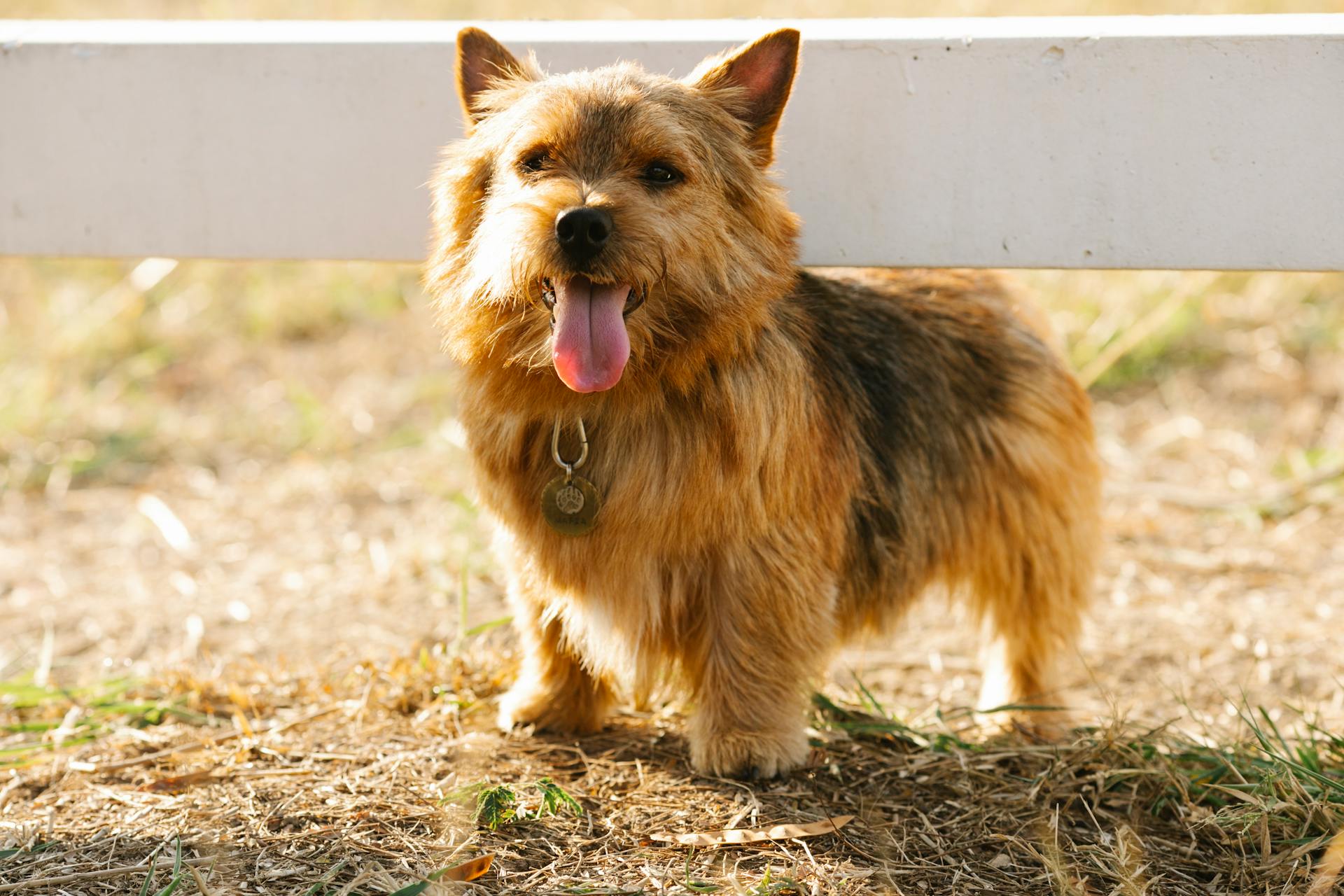
Dog pedigree charts are a crucial tool for dog breeders and enthusiasts alike. They provide a visual representation of a dog's ancestry, making it easier to identify potential health issues and desirable traits.
A dog pedigree chart typically includes information about a dog's parents, grandparents, and other ancestors. This can be especially useful for breeders who want to create a litter with specific characteristics.
The chart may also include details about the dog's breed, registration number, and any notable achievements or titles it has earned. This information can be a great conversation starter and help you learn more about your dog's heritage.
Understanding a dog pedigree chart can also help you make informed decisions about your dog's health and well-being. By knowing your dog's ancestry, you can identify potential health risks and take steps to prevent them.
Understanding Dog Pedigree Charts
A dog's pedigree chart is like a family tree, showing the dog's ancestry and breeding history. It's a valuable tool for dog owners and breeders alike.
The AKC pedigree chart is a traditional ancestry pedigree, meaning it lists the dog's direct ancestors, starting with the dog on the left and branching out to the right. This chart is read from left to right, with each generation listed below the previous one.
To read a dog's pedigree chart, start by finding the dog's registered name and birth date, which should be listed on the chart. This information is usually found in the top left or right corner of the chart.
The chart should list the names of the dog's parents, grandparents, and great-grandparents, and so on. If you see repeated names, it may indicate that the ancestors were closely related, which can be a sign of inbreeding or line-breeding.
You may also see DNA numbers listed on the chart, which identify a dog's genetic makeup. These numbers can be found next to the dog's name.
A pedigree chart can also display show records if the dog or its ancestors were awarded in notable competitions. Abbreviated titles, such as "BH" or "FH2", may be listed on the chart to indicate desirable traits, such as tracking or herding.
Here's a breakdown of what to look for in a pedigree chart:
Understanding a dog's pedigree chart can help you learn more about the dog's ancestry and breeding history, and can be a valuable resource for dog owners and breeders.
Interpreting Pedigree Charts
A pedigree chart is a family tree for your dog, tracking their ancestry. It's a way to see where your dog's desirable traits come from.
A certified pedigree marks your dog as a purebred for three generations back, according to Ryan Corrigan, a Licensed Veterinary Technician. This means you can trust that your dog's ancestry is well-documented.
A good pedigree often means that your dog's family were show winners or have particularly desirable traits, as Ryan Corrigan explains. This can be a great selling point for breeders or a fun fact for owners.
Other Types
The traditional ancestry pedigree is a valuable breeding tool for determining the depth of pedigree, which considers the traits and assets of the ancestors in the first three or four generations.
This type of pedigree can be very important in determining the likelihood of certain traits or health issues being passed down to your dog.
A good depth of pedigree means that most of your dog's ancestors are Champions or have certain health clearances, which can be a great asset in breeding.
However, it's also essential to consider the breadth of pedigree, which looks at the siblings of each of your dog's ancestors.
The breadth of pedigree can give you more information than the depth of pedigree, but it can get complicated to absorb everything.
In some cases, you may need to balance the information from the depth of pedigree with that from the breadth of pedigree to make your best breeding decision.
A descendant pedigree, which originates with your dog and lists offspring and their offspring for several generations, can also yield valuable information.
This type of pedigree can be especially useful if you're considering a dog for breeding and want to know if they have clear hips, but most of their progeny don't.
Using a trait or symbol pedigree, which is often used in medical and genetic research, can help you combine all the information from direct ancestors, siblings, and descendants into one pedigree.
In such a pedigree, males are shown as squares and females as circles, with horizontal lines connecting breeding pairs and vertical lines reaching down to their offspring.
Expert Q&A
A pedigree chart can be a treasure trove of information about your dog's ancestors and their achievements. You can register your dog online and pay the fee to get an AKC registration.
If you're looking for a dog with a good pedigree, it means that the dog's family has been successful in show competitions or has desirable traits. A certified pedigree marks your dog as a purebred for three generations back.
To decode title abbreviations, look for show records and ask the breeder or kennel association to explain if you're not sure what the titles mean. Many breeds can be awarded special titles that recognize highly desirable traits.
Here's a list of some common title abbreviations:
These are just a few examples of the many titles and abbreviations you might see on a pedigree chart. By taking the time to understand what they mean, you can gain a deeper appreciation for your dog's ancestry and their achievements.
Resources and Templates
If you're looking for a way to organize your dog's family tree, there are some great resources available.
You can use a fifth generation pedigree chart, which includes the names of your dog, grandparents, great grandparents, great great grandparents, and great great great grandparents.
A blank pedigree chart sample is also a useful tool for keeping track of your dog's family tree, including information like birthplace, marriage, and death dates.
These templates can be downloaded as PDFs, making it easy to print and use them to record your dog's family history.
Additional reading: Are Boxer Dogs Good Family Dogs
Editing Forms Online for Free
Editing forms online for free is now easier than ever. You can use a PDF editor to fill out printable blank dog pedigree charts without having to download any applications.
The PDF editor allows you to change PDF files in various ways, such as adding personalized text, correcting existing content, and placing signatures.
To get started, simply click the "Get Form Button" in the top section of the page. This will open the editor and allow you to begin filling out your form.
The editor is designed to be user-friendly and efficient, with regular updates and enhancements to make it easier to use.
5th Gen Sample PDF Template

The 5th Gen Sample PDF Template is a chart used to keep additional information of a dog's family tree. It includes the names of the dog, grandparents, great grandparents, great great grandparents, and great great great grandparents.
This type of template is particularly useful for tracking the lineage of a dog. You can easily see the relationships between the different generations and keep track of important details.
To create a comprehensive pedigree chart, you can use a blank pedigree chart sample PDF template. This type of template includes space for information like Born, Place, Married, and Died, making it easy to keep track of a dog's family tree.
The 5th Gen Sample PDF Template is a great resource for anyone who wants to learn more about their dog's ancestry. By using this template, you can gain a deeper understanding of your dog's family history and make informed decisions about their care.
Frequently Asked Questions
How do I get a pedigree chart for my dog?
To obtain a pedigree chart for your dog, you can purchase one online or by mail, or contact the AKC's Order Desk Department via email with your request. You can also send a check, money order, or credit card payment to the AKC's address in Raleigh, NC.
How do you read a dog's pedigree?
To read a dog's pedigree, start with the dam (mother) and sire (father) names, then move right to list grandparents, great-grandparents, and other ancestors. A proper pedigree lists the official names of all ancestors, helping you understand a dog's family history.
How do I make my dog pedigree?
To create a dog pedigree, start by gathering essential information about your dog, including its name, birthdate, breed, and registration details, as well as its parents' names, registration numbers, and any titles or awards they've received. Begin by collecting this information to establish a solid foundation for your dog's pedigree.
What is the free software for pedigrees?
There is no free software specifically for creating pedigree charts, but SmartDraw is a popular and highly-rated option for making pedigree charts online.
Sources
- https://www.akc.org/expert-advice/dog-breeds/how-to-read-and-use-my-dogs-pedigree/
- https://justamere.com/title-abbreviations-in-pedigree/
- https://www.wikihow.pet/Read-a-Dog%27s-Pedigree
- https://formspal.com/pdf-forms/other/dog-pedigree-chart-form/
- https://www.template.net/business/charts/pedigree-chart/
Featured Images: pexels.com


